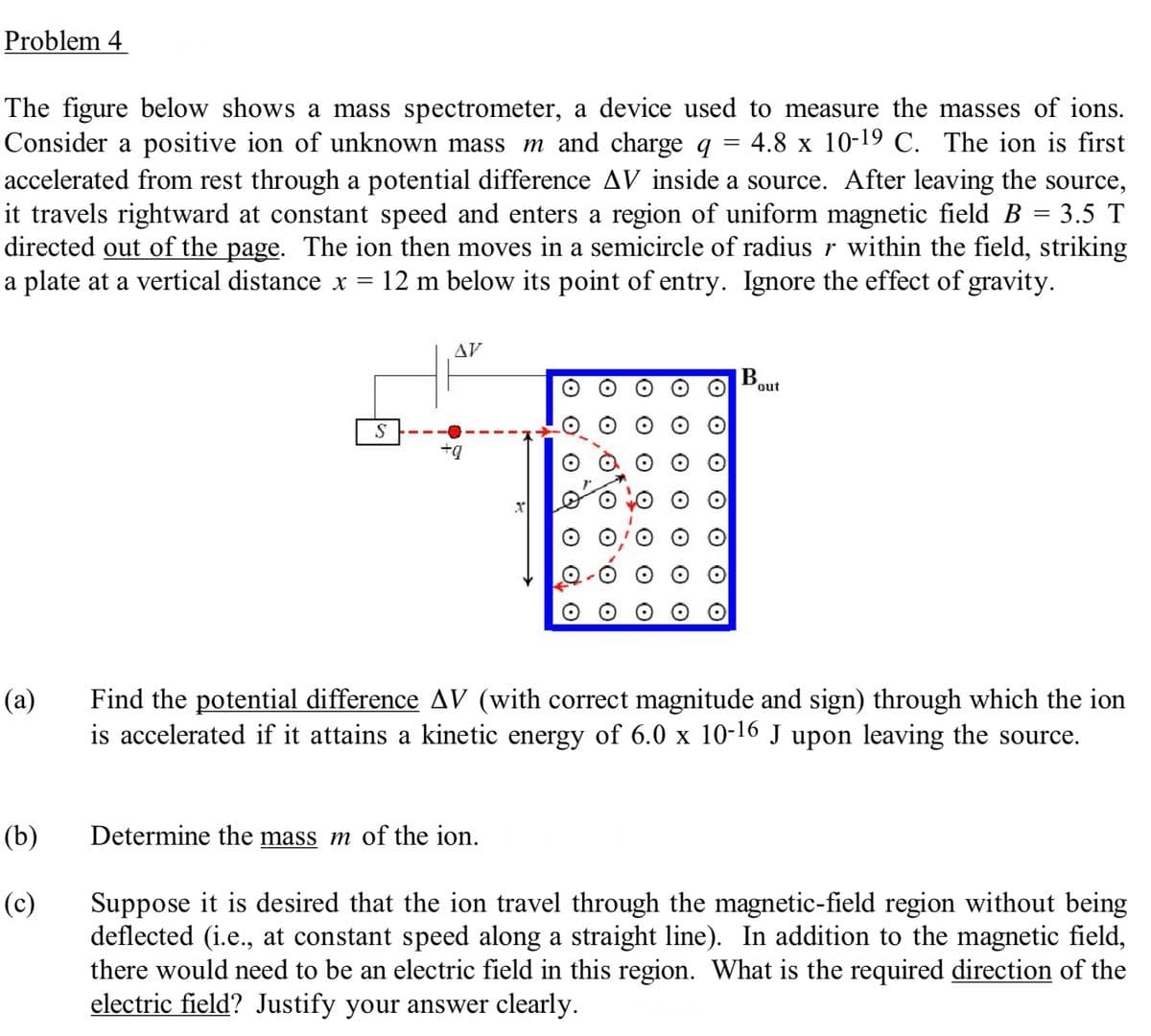Problem 4 = The figure below shows a mass spectrometer, a device used to measure the masses of ions. Consider a positive ion of unknown mass m and charge q 4.8 x 10-19 C. The ion is first accelerated from rest through a potential difference AV inside a source. After leaving the source, it travels rightward at constant speed and enters a region of uniform magnetic field B = 3.5 T directed out of the page. The ion then moves in a semicircle of radius r within the field, striking a plate at a vertical distance x = 12 m below its point of entry. Ignore the effect of gravity. (a) (b) (c) S ΔΙ +q O Determine the mass m of the ion. 0 0 0 0 0 0,00 000 O QO 0 0 0 0 0 0 0 0 0 0 0 0 out Find the potential difference AV (with correct magnitude and sign) through which the ion is accelerated if it attains a kinetic energy of 6.0 x 10-16 J upon leaving the source. Suppose it is desired that the ion travel through the magnetic-field region without being deflected (i.e., at constant speed along a straight line). In addition to the magnetic field, there would need to be an electric field in this region. What is the required direction of the electric field? Justify your answer clearly.
Problem 4 = The figure below shows a mass spectrometer, a device used to measure the masses of ions. Consider a positive ion of unknown mass m and charge q 4.8 x 10-19 C. The ion is first accelerated from rest through a potential difference AV inside a source. After leaving the source, it travels rightward at constant speed and enters a region of uniform magnetic field B = 3.5 T directed out of the page. The ion then moves in a semicircle of radius r within the field, striking a plate at a vertical distance x = 12 m below its point of entry. Ignore the effect of gravity. (a) (b) (c) S ΔΙ +q O Determine the mass m of the ion. 0 0 0 0 0 0,00 000 O QO 0 0 0 0 0 0 0 0 0 0 0 0 out Find the potential difference AV (with correct magnitude and sign) through which the ion is accelerated if it attains a kinetic energy of 6.0 x 10-16 J upon leaving the source. Suppose it is desired that the ion travel through the magnetic-field region without being deflected (i.e., at constant speed along a straight line). In addition to the magnetic field, there would need to be an electric field in this region. What is the required direction of the electric field? Justify your answer clearly.
Principles of Physics: A Calculus-Based Text
5th Edition
ISBN:9781133104261
Author:Raymond A. Serway, John W. Jewett
Publisher:Raymond A. Serway, John W. Jewett
Chapter22: Magnetic Forces And Magnetic Fields
Section: Chapter Questions
Problem 80P
Related questions
Question

Transcribed Image Text:Problem 4
=
The figure below shows a mass spectrometer, a device used to measure the masses of ions.
Consider a positive ion of unknown mass m and charge q 4.8 x 10-19 C. The ion is first
accelerated from rest through a potential difference AV inside a source. After leaving the source,
it travels rightward at constant speed and enters a region of uniform magnetic field B 3.5 T
directed out of the page. The ion then moves in a semicircle of radius r within the field, striking
a plate at a vertical distance x = 12 m below its point of entry. Ignore the effect of gravity.
(a)
(b)
(c)
S
ᎪᏤ
+q
O QO
Determine the mass m of the ion.
B
out
Find the potential difference AV (with correct magnitude and sign) through which the ion
is accelerated if it attains a kinetic energy of 6.0 x 10-16 J upon leaving the source.
Suppose it is desired that the ion travel through the magnetic-field region without being
deflected (i.e., at constant speed along a straight line). In addition to the magnetic field,
there would need to be an electric field in this region. What is the required direction of the
electric field? Justify your answer clearly.
Expert Solution
This question has been solved!
Explore an expertly crafted, step-by-step solution for a thorough understanding of key concepts.
Step by step
Solved in 3 steps with 3 images

Knowledge Booster
Learn more about
Need a deep-dive on the concept behind this application? Look no further. Learn more about this topic, physics and related others by exploring similar questions and additional content below.Recommended textbooks for you

Principles of Physics: A Calculus-Based Text
Physics
ISBN:
9781133104261
Author:
Raymond A. Serway, John W. Jewett
Publisher:
Cengage Learning

Physics for Scientists and Engineers with Modern …
Physics
ISBN:
9781337553292
Author:
Raymond A. Serway, John W. Jewett
Publisher:
Cengage Learning

Physics for Scientists and Engineers
Physics
ISBN:
9781337553278
Author:
Raymond A. Serway, John W. Jewett
Publisher:
Cengage Learning

Principles of Physics: A Calculus-Based Text
Physics
ISBN:
9781133104261
Author:
Raymond A. Serway, John W. Jewett
Publisher:
Cengage Learning

Physics for Scientists and Engineers with Modern …
Physics
ISBN:
9781337553292
Author:
Raymond A. Serway, John W. Jewett
Publisher:
Cengage Learning

Physics for Scientists and Engineers
Physics
ISBN:
9781337553278
Author:
Raymond A. Serway, John W. Jewett
Publisher:
Cengage Learning

College Physics
Physics
ISBN:
9781285737027
Author:
Raymond A. Serway, Chris Vuille
Publisher:
Cengage Learning

College Physics
Physics
ISBN:
9781305952300
Author:
Raymond A. Serway, Chris Vuille
Publisher:
Cengage Learning
